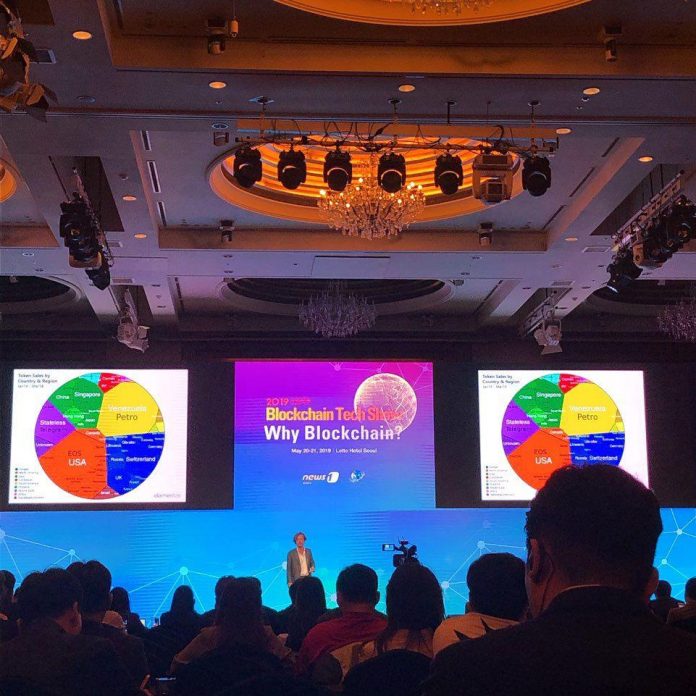
On May 21, the 4th Korea Future Forum invited blockchain industry experts from both domestic and overseas, and held special blockchain session named ‘Blockchain Tech Show’ at Lotte Hotel Seoul.
This event was co-hosted by News1, a private news agency launched by Money Today Media Group in 2011, and the UN Future Forum, which is called ‘think tank of future research’ (established under the Ministry of Economy and Finance in 2004). They made an atmosphere to discuss the practical use of blockchain technology, which is one of the major trends that will dominate future society, in terms of individual and corporate side, the emerging issues at this stage, ways to overcome the issues, and the reasonable policy direction in the future.

Many professionals gathered from Korea and abroad, including Brock Pierce, chairman of Bitcoin Foundation, also known as ‘genius of crypto-investment’, Nitin Gaur, managing director of IBM Global Digital Asset Research Lab, Jae Hyun Park, CEO of Lambda256, Shlomo Cohen, EMEA logistics general manager of IBM, Seok Hwan Kim, CEO of Wemade Tree, Jung Won Kim, Internet convergence policy officer of Ministry of Science and ICT, Jong Hyup Kim, director of ICON Foundation, and Jong Ho Kim, CEO of Haechi Labs to discuss present situation and current challenges of blockchain technology.
 Brock Pierce, chairman of Bitcoin Foundation, also known as ‘genius of crypto-investment’ was confident that “The spring will come” in the crypto market this year.
Brock Pierce, chairman of Bitcoin Foundation, also known as ‘genius of crypto-investment’ was confident that “The spring will come” in the crypto market this year.
He expected that the blockchain technology and crypto market, which had been suffering from groundless ‘speculation frenzy’ for the last two years, will be recognized as a true value from this year, and a radical change will begin with decentralized system that overcomes the limitations of existing centralized system. “Blockchain is at a turning point and many companies around the world are now saying that the time has arrived,” he said in the keynote speech. Also he added, “From the second half of this year, there will be a significant change in ownership and capitalization of data.”
In the following section, Nitin Gaur, managing director of IBM presented under the theme of ‘The future of public and private blockchain.’ “Blockchain technology, which cannot be forged and provides the highest level of security, can offer trust between members and participants and reduce unnecessary waste of time,” he said. He advised that “We should introduce and build a right governance model to make the blockchain a mainstream platform.”

Experts said that “The spring has come” unanimously, and they anticipated that the blockchain technology will be popularized in earnest this year. They analyzed that the blockchain technology has begun to be applied in earnest in order to realize the intrinsic value of the technology and to overcome the limitations of the existing centralized system throughout the society.
In addition, they expected blockchain technology to increase business efficiency and create new opportunities for companies. “Blockchain and IoT technology is a ‘game changer’ that will make a big change in a supply chain,” said Shlomo Cohen, EMEA logistics general manager of IBM. “Blockchain technology will be able to decrease inefficiency of the supply chain by using the characteristics that it cannot be counterfeited and it does not need intermediaries,” he added.
As the government responds to the atmosphere of industry, it is developing blockchain technology and creating ecosystem. Jung Won Kim, Internet convergence policy officer of Ministry of Science and ICT, announced that the government plans to raise the level of blockchain technology up to 90% of the US by 2022 and to develop about 10,000 people of related professional manpower and 100 companies by 2022.
“The government will try to activate blockchain to create value and build a digital trust society,” and “The government is going to support the blockchain technology to be activated by private sector,” he said.
About 150 people attended the event, and most of them were crypto industry workers in the 30s and 40s. There were a total of 7 booths in the venue, but only a few people visited the booths. Most attendees were focused on speeches rather than networking.
Overall, all sections went smoothly and many attendees enjoyed interesting and informative speeches of speakers. But the “promotional purposes” intervention of some attendees, who were not related to this event, made frown on the other attendees.


![[November]Uptober No More](https://coinhubkorea.com/wp-content/uploads/2025/10/Whisk_d78880efb01a730907f4be201effefe1dr-1-324x235.jpeg)



